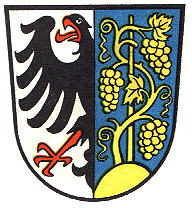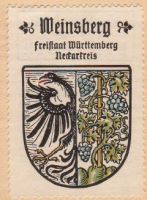Weinsberg: Difference between revisions
Knorrepoes (talk | contribs) m (Text replacement - "{{media}} Literature : Stadler, 1964-1971, 8 volumes." to "Literature : Stadler, 1964-1971, 8 volumes. {{media}}") |
Knorrepoes (talk | contribs) m (Text replacement - "Literature :" to "'''Literature''':") |
||
| Line 29: | Line 29: | ||
</gallery> | </gallery> | ||
[[Civic Heraldry Literature - Germany|Literature]] : Stadler, 1964-1971, 8 volumes. | [[Civic Heraldry Literature - Germany|'''Literature''']]: Stadler, 1964-1971, 8 volumes. | ||
{{media}} | {{media}} | ||
Revision as of 22:16, 9 September 2022
This page is part of the German heraldry portal |
Heraldry of the World |
|
German heraldry:
|
Selected collector's items from Germany:
|
WEINSBERG
State : Baden-Württemberg
District (Kreis) : Heilbronn
Additions : 1973 Grantschen; 1975 Gellmersbach, Wimmental
| German |
In gespaltenem Schild vorne in Silber ein rotbewehrter und rotbezungter halber schwarzer Adler am Spalt, hinten in Blau auf goldenem Berg ein goldener Rebstock an goldenem Pfahl. |
| English | No blazon/translation known. Please click here to send your (heraldic !) blazon or translation |
Origin/meaning
Weinsberg was founded as a city in the 14th century and remained a possession of the Lords of Weinsberg until 1430. In 1440 the city became part of the Palatinate and in 1504 of Württemberg.
The oldest known seal dates from 1318 and shows, as does the second seal, only the canting vine on a mountain (Wein=vine, Berg=mountain). The imperial eagle was added in the middle of the 15th century. Until the middle of the 19th century the eagle was either used alone or with the vine on a breast shield. Since the middle of the 19th century the present composition is used.
The arms by Hupp in the Kaffee Hag albums +/- 1925
Literature: Stadler, 1964-1971, 8 volumes.
Contact and Support
Partners:
Your logo here ?
Contact us
© since 1995, Heraldry of the World, Ralf Hartemink 
Index of the site














